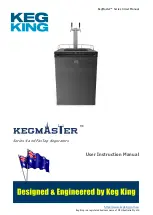
Product Code: PROTL500A
Made in China to TQB Brands Pty Ltd specifications
Page 5
Visit us at www.tqbbrands.com.au
15.
Test the hydraulic power unit without load by raising it to full height.
16.
Lower the fully extended hydraulic ram by pushing the foot operated Release Pedal (34) down gently to control the rate
of descent.
17.
Your Hydraulic Transmission Lifter is ready for use.
*The range of TQPro Transmission Lifters use 32 Grade Hydraulic Oil for the correct operation and compatibility with the seals
used in their construction.
4.
OPERATION
WARNING
Vehicle must be properly and adequately supported before commencing work with this telescopic Transmission Lifter.
To remove transmission from raised vehicle
1.
Always loosen the Air Vent Screw (26) before use.
2.
Roll the Transmission Lifter into position and lock the Castor Wheel (47) brakes.
3.
Connect the air supply and push the Air Trigger Valve (54) or Pump the foot operated Lift Pedal (38) until the Transmission
Cradle (04) reaches the desired height.
NOTE:
Follow the vehicle manufacturer's recommended procedures for removing the load as outlined in the vehicle
service manual or repair guide.
4.
Carefully centre the load on the cradle. Ensure the load's centre of gravity is centred on the cradle and the transmission
is stable and secure. Use the chains to secure the load.
NOTE:
Before lowering the load check to ensure all tools and personnel are clear and it is safe to lower the load.
5.
SLOWLY and CAREFULLY push the foot operated Release Pedal (34) to lower the load to its lowest position.
NOTE:
The speed of lowering is controlled by pressure on the release valve. The more the valve is opened the more
rapidly the load descends. Always ensure the decent is slow and controlled.
6.
Once the load is lowered, release the castor wheel brakes.
7.
CAREFULLY and SLOWLY move the transmission lifter from under the vehicle.
8.
Immediately transfer the load to a bench top or appropriate support device for service or repair.
To install transmission into raised vehicle
1.
Always loosen the Air Vent Screw (26) before use.
2.
Roll the Transmission Lifter into position and lock the Castor Wheel (47) brakes.
3.
Transfer the load from the bench top or appropriate support device to the Transmission Lifter.
4.
Carefully centre the load on the cradle. Ensure the load's centre of gravity is centred on the cradle and the transmission
is stable and secure. Use the chains to secure the load.
5.
Unlock the Castor Wheel brakes and carefully roll the transmission lifter into position beneath the vehicle and lock the
castor wheel brakes.
6.
Connect the air supply and push the Air Trigger Valve (54) or Pump the foot operated Lift Pedal (38) until the Transmission
reaches the desired height.
NOTE:
Follow the vehicle manufacturer's recommended procedures for installing the load as outlined in the vehicle
service manual or repair guide.
7.
SLOWLY and CAREFULLY push the foot operated Release Pedal (34) to lower the load to its lowest position.
NOTE:
The speed of lowering is controlled by pressure on the release valve. The more the valve is opened the more
rapidly the load descends. Ensure the decent is slow and controlled.
8.
Once the cradle is lowered, release the castor wheel brakes.
9.
CAREFULLY move the transmission lifter from under the vehicle.
10.
When work is complete, ensure the cradle is at its lowest position and tighten the air vent screw to store.
WARNING
Dangerous dynamic shock loads are created by quick opening and closing the release valve when the load is being lowered.
The resulting overload may cause hydraulic system failure which could cause property damage and/or severe personal injury.





























